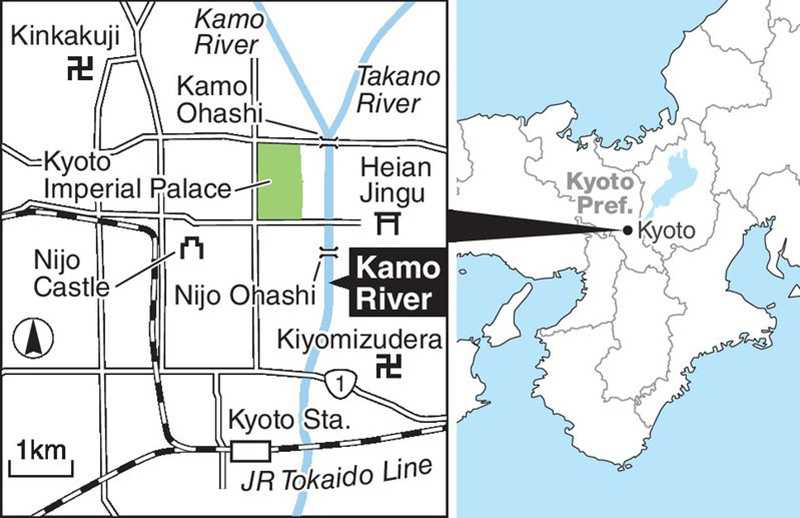
A person crosses the Kamo River using stepping-stones, some shaped like an omusubi rice ball, in Kyoto.
16:47 JST, February 5, 2022
KYOTO — The Kamo River runs about 23 kilometers from north to south in the middle of the urban area of Kyoto, and is familiar even to foreign tourists.
Many people have probably seen stones purposely placed in the stream of a river. The Kamo River has stepping-stones allowing pedestrians to walk across it.
There are in total six sets of stepping-stones on the Kamo River north of the Nijo Ohashi bridge and on the Takano River. Many of these stepping-stones have attractive shapes, such as turtles, boats and omusubi rice balls, and have become part of the city’s unique landscape.
People can be seen constantly coming and going atop these stones, even though there is a bridge nearby. A student in a hurry, a woman walking her dog, elderly people taking a stroll, and more. But why do they use the stepping-stones?
“It’s nice to walk over the river, isn’t it? Besides, it’s the shortest route to my office,” said a man in his 40s.
The stepping-stones seem to have become an indispensable pathway for citizens.
The stones have a surprisingly short history, being installed not so long ago, in 1992-94. Kyoto prefectural government officials designed these stepping-stones in order to familiarize people with the river. At the time, the disconnect of the populace from the river was so great that Japanese children’s school handbooks said, “Do not approach the river, because it is dangerous.”

“We thought that we could prevent accidents on the river by making people aware of its characteristics,” recalled Shigenori Yoshimi, a former employee of the prefecture’s Kyoto civil engineering office.
Nowadays, the Kamo River is often crowded with children playing in the water during the summer holidays.
Yoshimi, 65, hopes that parents and children will use these stones as a guide to judge the water level, saying, “Today the turtle is up to its neck in water, so we should be careful.”
Besides serving as a pathway, stepping-stones have an added unexpected effect. The stones hold back the gravel being swept down by the rapids and prevent the riverbed from being gouged deeper. As a result, the flow of the Kamo River is more stable and the water is fairly smooth.

A stepping-stone in the shape of a turtle

A stepping-stone shaped like a boat
The Kamo River, left, and Takano River are seen from the Kamo Ohashi bridge. The two rivers join further downstream.
“If we artificially flatten the riverbed, some fish will no longer be able to live there. By placing stepping-stones, a balance can be achieved between the environment and the need for flood control,” Yoshimi said.
The distance between the stones is 40 to 80 centimeters. Any worries about falling off vanish once you reach the center of the path, as the surrounding noise of the city is replaced by the gentle burbling of the river.
People continue to come and go on the stones, enjoying a sense of free luxury that is hard to find in the city.
Origin of river’s name up in the air

The Kamo River, left, and Takano River are seen from the Kamo Ohashi bridge. The two rivers join further downstream.
KYOTO — Around 1100, retired emperor Shirakawa, who was immensely powerful at the time, listed the water of the Kamo River as one of the top three things that he could not control. The remaining two were a roll of the dice and the monks of the Hieizan Enryakuji temple, which then had strong influence and wealth.
This is a testament to Shirakawa’s incomparable power, but also indicates that the Kamo River has been a raging river since then.
Centuries later around 1800, the famous novelist Takizawa Bakin listed the Kamo River as one of the best three things about Kyoto, along with “girls” and “temples and shrines.”
The Kamo River has long attracted the hearts of Japanese people because of its duality — roughness and beauty.
The kanji character for “kamo” means wild duck. However, there are many theories about the origin of the river’s name, and the notion of it being known for a large number of wild ducks is not dominant.
The name is generally believed to have come from the Kamo clan, a powerful family who had lived along the river since ancient times.
In fact, the Kamo River uses different kanji characters to the north and south of its confluence with the Takano River. South of this point, the kanji for “wild duck” is used, while north of this point, the kanji for the Kamo clan name is used. However, some people believe that the word originated from the word “kami,” meaning upstream or deity.
Related Tags
"Features" POPULAR ARTICLE
-

Sanrio to Open Museum in Yamanashi Pref. Dedicated to Founder, Exhibits Include Hello Kitty, Other Characters
-

Autumn Foliage Surrounds Visitors to Tokyo’s Showa Kinen Park
-

My Daughter No Longer Speaks to Me, But I Want to See Her and My Grandchild
-

Kumamoto: Public Bath Refurbished as Library Where You Can Chat, Take Photos
-

Frozen Vegetables: Demand Rises for Convenient, Tasty Domestic Produce
JN ACCESS RANKING
-

Keidanren Chairman Yoshinobu Tsutsui Visits Kashiwazaki-Kariwa Nuclear Power Plant; Inspects New Emergency Safety System
-

Imports of Rare Earths from China Facing Delays, May Be Caused by Deterioration of Japan-China Relations
-

University of Tokyo Professor Discusses Japanese Economic Security in Interview Ahead of Forum
-

Tokyo Economic Security Forum to Hold Inaugural Meeting Amid Tense Global Environment
-

Japan Pulls out of Vietnam Nuclear Project, Complicating Hanoi’s Power Plans

























